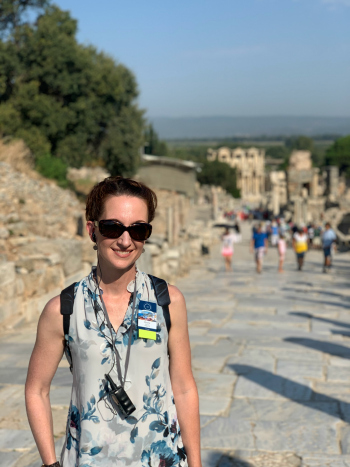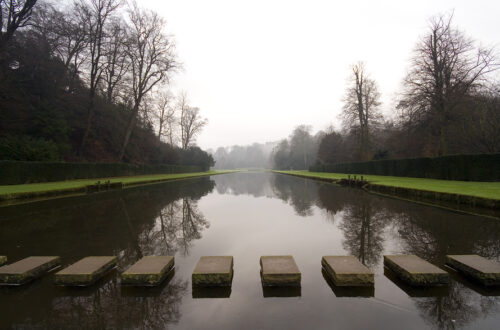
Journey With Me to Ephesus
This month I take you on a photographic tour of Ephesus. The city of Ephesus was the capital of the Roman province of Asia (Asia Minor, modern Turkey). It was an important political, educational, and commercial center as it was the gateway to Asia. It was a strategic military location and the hub for caravan travel. Ephesus was also known for the temple of Artemis, one of the Seven Wonders of the Ancient World (Acts 19:35). (To learn more about Artemis, please see the blogs linked below.)
As it was such an important commercial center and located on the coast of the Aegean Sea, it was an affluent city. Its markets would have boasted of dazzling fabrics such as exquisite silk and wool.[1] Ephesus researcher and seminary professor, Dr. Sandra Glahn states that Ephesus would have also had a “healthy trade in sea-jewels,” such as pearls.[2]
The apostle Paul spent part of his second and third missionary journeys in Ephesus teaching both Jews and Gentiles (Acts 18:19, Acts 19:8–10, 1 Cor. 16:8). He wrote a letter to believers at Ephesus and surrounding churches of the area commending them for their strong faith in the Lord Jesus and their love for fellow believers (Eph. 1:1, 15). Priscilla and Aquila, fellow tentmakers and missionaries with Paul, were also in Ephesus and taught Apollos more “accurately the facts about Jesus” (Acts 18:24–28). Paul’s protégé, Timothy, spent time instructing believers in Ephesus (1 Tim. 1:3). Lastly, the apostle John spent part of his later years in Ephesus.
Ephesus was not only a major hub for trade and commerce; it was a major hub for the gospel.
Ephesus was one of the seven churches that John wrote to in Revelation. Though the believers in Ephesus started strong (see Paul’s commendation above), somewhere along the way they lost focus in their hard work for the Lord and, as John writes, “departed from [their] first love,” that being Jesus (Rev. 2:1–7).
Why is it so important to know the historical background of Ephesus as well as have some understanding of its physical appearance?
1. Proper historical background helps lend a biblical scholar (whether a layperson reading the Bible for themselves or a pastoral leader teaching others) to a more proper interpretation of the biblical text.
- Ever wonder why it was necessary for Paul to emphasize unity and oneness in Christ in his letter to the Ephesians? (Eph. 2:11–22)
- Paul used metaphors of a building with a cornerstone, a holy temple, and a residential dwelling (Eph. 2:20–22) to give explanation to new life in the family of Christ. Every wonder what the buildings and homes of Ephesus looked like?
- Why did Paul care how women were attired, adorned, or wore their hair? (1 Tim 2:9–10)
2. Touring important biblical cities (even just in photos) makes the Bible come more alive as we read and study it, which naturally leads to better biblical memory retention and recall.
Without further ado, please journey with me to Ephesus. I hope from my photos taken during a recent trip you can grasp just how grand, large, and opulent was the city of Ephesus. As you peruse these photos, keep in mind archeologists estimate that only ten percent of the ruins of Ephesus have been excavated. This city was indeed a large metropolis.

Streets of Ephesus: Lined with traditional Roman Corinthian and Doric columns. Imagine the apostle Paul and his companions, such as Aquila and Priscilla, walking this street.

The Great Theater: As this theater was under reconstruction at the time of Paul’s visits to Ephesus, Paul probably did not preach here. But it was an impressive structure, accommodating up to 24,000 spectators during its peak use.[3]

The Arcadian Way: Main boulevard/street in Ephesus leading from the Great Theater.

Terrace Homes: These high-end apartments were built into a hillside and featured wall paintings portraying Roman educational and social values. The homes boasted of exquisite mosaic tile floors. The closer the home was to the city center, the more expensive was the home and the more affluent was the family, versus the homes higher in the hills (think suburbs) were less expensive homes.

The Odeum: Acts 19:9 explains that after the apostle Paul was rejected by the Jews, he preached in the lecture hall of Tyrannus. The exact location of this lecture hall is unknown. But it was possibly here, at the Odeum, as this was a place where the men of Ephesus would gather for lectures about philosophy and religion.[4]



Columns, Colonnades, and Cats: For the simple reason I love architecture and cats.

Facade of the Library of Celsus: Built in honor of the second century Roman governor of Asia Minor, Julius Celsus Polemaenus, it served as a mausoleum and library of manuscripts. (Photo courtesy of Katie Hayes.)

Facade of the Library of Celsus (Night)

Bird’s Eye View of Ephesus: Taken from the top of the terrace homes excavated thus far. The Great Theater is in the distance (look for the tower crane.)

Bird’s Eye View of Ephesus: Showing streets of Ephesus and Library facade in the distance.
Take-Away: Now that you have a better understanding of Ephesus, how does knowing its history and physicality impact your Bible reading? Has it changed or even just expanded some of your biblical understanding? Please comment.
Additional Resources:
For more information regarding Ephesus, Artemis of Ephesus, and why the Apostle Paul was so concerned what women wore, please read these blog posts by author and seminary professor Dr. Sandra Glahn:
The Key to Unlocking a City’s Mentality (i.e. Athens, Corinth, and Ephesus)
Who Was Artemis and Why Does It Matter?
Who Was Artemis and Why Does It Matter? Part II
Not With Braided Hair . . . or Pearls
Author and professor Dr. Wayne Stiles also has great blogs about Ephesus:
An Ephesus Question: What Comes First in Your Relationship with God?
[1] Glahn, Sandra. ‘Not with Braided Hair . . . or Pearls’. Bible.org Engage Blog, 2010. Accessed August 20, 2019. https://blogs.bible.org/not-with-braided-hair-or-pearls/
[2] Glahn, Sandra. ‘Not with Braided Hair . . . or Pearls’. Bible.org Engage Blog, 2010. Accessed August 20, 2019. https://blogs.bible.org/not-with-braided-hair-or-pearls/
[3] Miszczak, Izabela. ‘Great Theater in Ephesus’. Turkish Archaeological News, 2016. Accessed September 9, 2019. https://turkisharchaeonews.net/object/great-theatre-ephesus
[4] Roberts, Mark. ‘Ancient Ephesus and the New Testament.’ Patheos, 2011. Accessed September 9, 2019. https://www.patheos.com/blogs/markdroberts/series/ancient-ephesus-and-the-new-testament/



